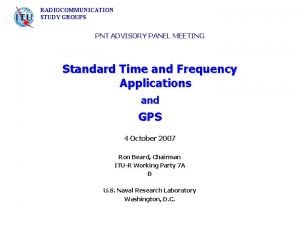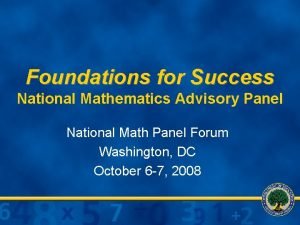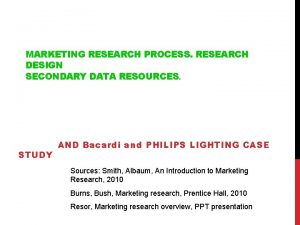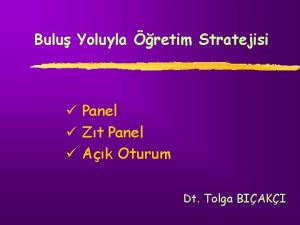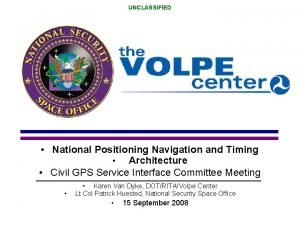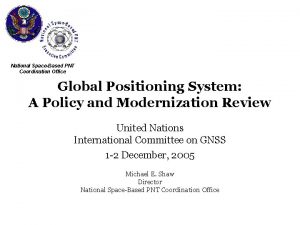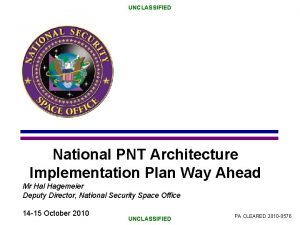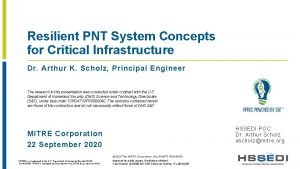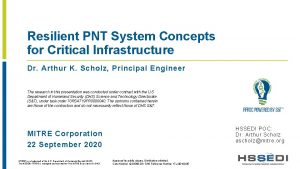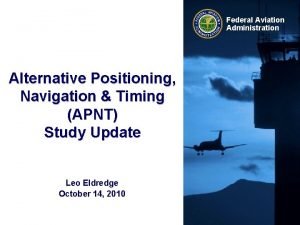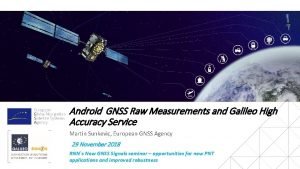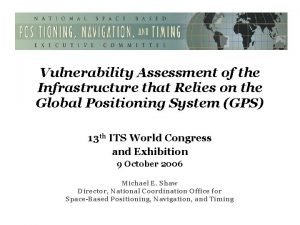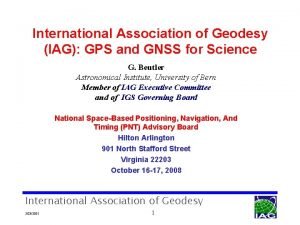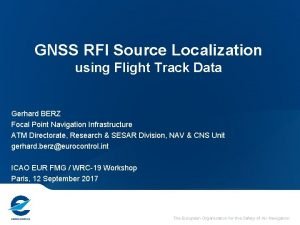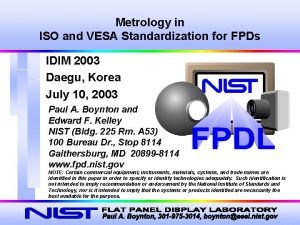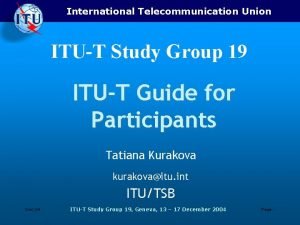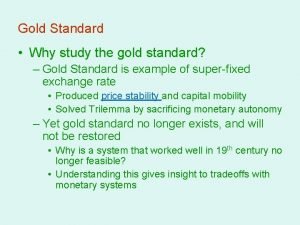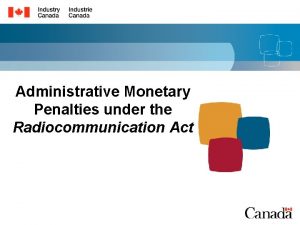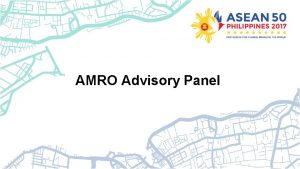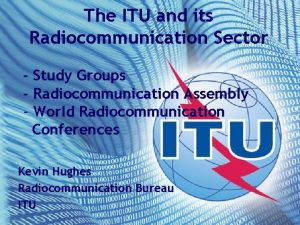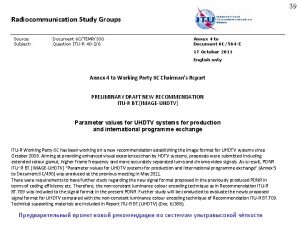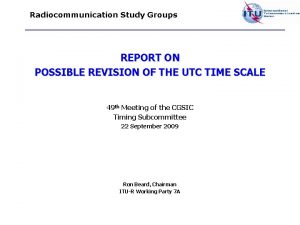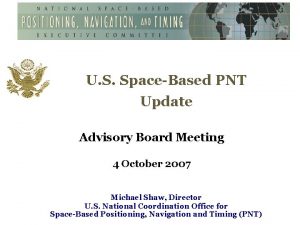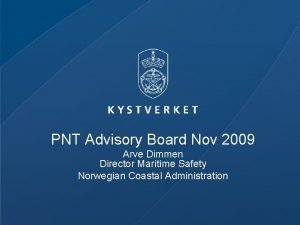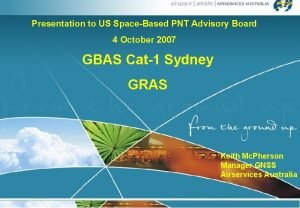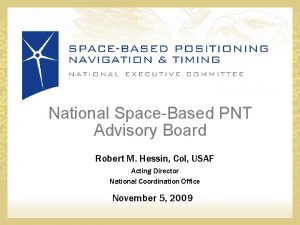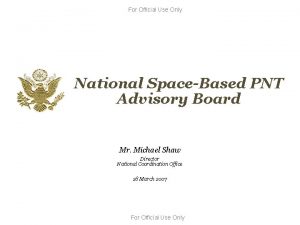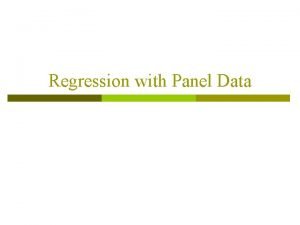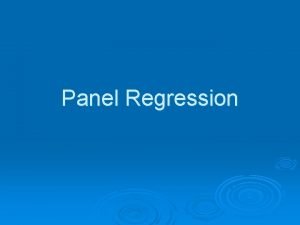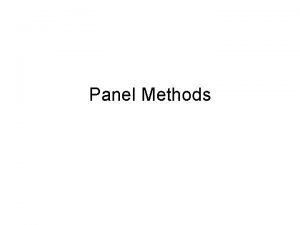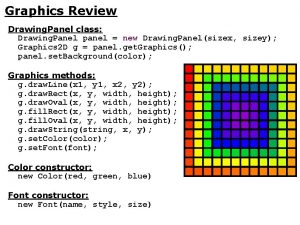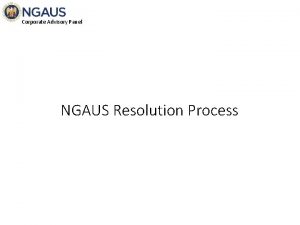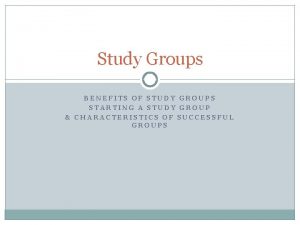RADIOCOMMUNICATION STUDY GROUPS PNT ADVISORY PANEL MEETING Standard



























- Slides: 27

RADIOCOMMUNICATION STUDY GROUPS PNT ADVISORY PANEL MEETING Standard Time and Frequency Applications and GPS 4 October 2007 Ron Beard, Chairman ITU-R Working Party 7 A B U. S. Naval Research Laboratory Washington, D. C.

RADIOCOMMUNICATION STUDY GROUPS TOPICS ITU-R’s Role in Standard Time and Frequency Signal Services The Role of GPS in Time Scales Broadcast Time and Frequency Services The Future of UTC IGS/NRL Clock Products Working Group The Role of GPS in Telecommunications Telephone Networks Cellular Networks Internet Timing Summary

RADIOCOMMUNICATION STUDY GROUPS ITU-R Study Group 7 Science Services Working Party 7 A Time Signals and Frequency Standard Emissions Responsible for Standard Frequency and Time Signal (STFS) services, both terrestrial and satellite. Scope includes the dissemination, reception and exchange of STFS services and coordination of these services, including satellite techniques, on a worldwide basis. Goals are to develop and maintain ITU-R Recommendations in the TF Series and Handbooks relevant to SFTS activities, covering the fundamentals of the SFTS generation, measurements and data processing. These ITU-R Recommendations are of paramount importance to telecommunication administrations and industry, to which they are first directed. They also have important consequences for other fields, such as radio navigation, electric power generation, space technology, scientific and metrological activities and cover the following topics: – Terrestrial SFTS transmissions, including HF, VHF, UHF broadcasts; television broadcasts; microwave link; coaxial and optical cables; – Space-based SFTS transmissions, including navigation satellites; communication satellites; meteorological satellites; – Time and frequency technology, including frequency standards and clocks; measurement systems; performance characterization; time scales; time codes

RADIOCOMMUNICATION STUDY GROUPS Coordinated Universal Time (UTC) Defined by ITU-R Recommendation TF 460 -6 A Stepped Atomic Time Scale Generated and Maintained by the BIPM Supported by the IERS in determination of (UTC – UT 1) Incorporated by Reference into the Radio Regulations Originated as a Common Reference for “Coordinating” time signals Compromise between Continuous Atomic Time and Solar Mean Time (Universal Time) Universal Time provides Solar Rotation Angle from Prime Meridian to Local Meridian needed for celestial navigation

RADIOCOMMUNICATION STUDY GROUPS DEFINITION OF UTC ITU-R TF. 460 -6 STANDARD-FREQUENCY AND TIME-SIGNAL EMISSIONS (1970 -1974 -1978 -1982 -1986 -1997 -2002) To maintain worldwide coordination of standard frequency and time signals Disseminate standard frequency and time signals in conformity with the SI second Continuing need for UT immediate availability to an uncertainty of 0. 1 second TAI - International reference timescale of atomic time based on SI second as realized on a rotating geoid. Continuous scale from origin 1 Jan 1958 TAI = UT 2 on January 1, 1958 0 h TT = TAI + 32. 184 s UTC - Basis of coordinated dissemination of standard frequency and time signals. Maintained by the BIPM. Corresponds exactly in rate with TAI but differs by integral number of seconds, adjusted by insertion or deletion of seconds to ensure agreement within 0. 9 s of UT 1. TAI – UTC = 33 s DUT 1 - Dissemination to include predicted difference UT 1 – UTC (values given by IERS in integral multiples of 0. 1 s) Leaps Seconds may be introduced as the last second of any UTC month. December and June Preferred, March and September second choice.

RADIOCOMMUNICATION STUDY GROUPS FUTURE OF THE UTC TIMESCALE Question ITU-R 236/7 (2001) 1. What are the requirements for globally-accepted time scales for use both in navigation and telecommunications systems, and for civil time-keeping? 2. What are the present and future requirements for the tolerance limit between UTC and UT 1? 3. Does the current leap second procedure satisfy user needs, or should an alternative procedure be developed? Proposed Modifications to UTC Definition 1. Change tolerance of UTC – UT 1 to one Hour (~500 years to accumulate) 2. Eliminate Leap Second 3. Create New Time Scale (Use of TAI not recommended by BIPM)

RADIOCOMMUNICATION STUDY GROUPS INTERNATIONAL TIME LINKS

RADIOCOMMUNICATION STUDY GROUPS BIPM Time Scale Generation

RADIOCOMMUNICATION STUDY GROUPS TAI-UT 1 Seconds TAI-GPST TAI-UTC

RADIOCOMMUNICATION STUDY GROUPS SYSTEM TIME KEEPING NEEDS Traditional timekeeping is a post processed value TAI and UTC are post processed time scales delayed from 30 to 60 days. Electronic systems are filled with oscillators and clocks generating time and frequency data that must be correlated across systems and nations in “Real. Time” Reference Time needs to be continuous and available on demand (“Real-Time”) More and More systems are adopting their own “system time”…. e. g. , GPS TIME The increasing number of systems could potentially result in a multiplicity of “system time scales” UTC should be the single common Reference Time

RADIOCOMMUNICATION STUDY GROUPS GPS TIME and UTC (USNO) UTC(USNO) is generated by USNO and participates as a contributor to BIPM/UTC. GPS users assume UTC(USNO) is the global reference but many use GPS Time directly The uncertainty with respect to UTC is disregarded or not-significant for most users GPS Time (GPST) is the system internal continuous timescale Primarily used for positioning and navigation Secondarily used for disseminating time GPST offset and uncertainty with respect to UTC

RADIOCOMMUNICATION STUDY GROUPS BIPM CIRCULAR T

RADIOCOMMUNICATION STUDY GROUPS IGS/BIPM Pilot Project (transitioned to Working Group in 2003) GOAL: Develop strategies to exploit geodetic techniques for improved global time/frequency comparisons Began March 1998 w/ participation of > 35 groups IGS contributions: global dual-frequency tracking network standards for operating geodetic stations efficient data delivery system state-of-the-art analysis groups/methods/products BIPM contributions: high-accuracy metrological standards/measurements timing calibration methods timescale algorithms & independent comparisons formation & dissemination of UTC

RADIOCOMMUNICATION STUDY GROUPS IGS CONTRIBUTING TIMING CENTERS IGS Site Time Lab Freq. Std. Location AMC 2 AMC H-Maser Colorado Springs, CO USA BOR 1 AOS Cesium Borowiec, Poland BRUS ORB H-Maser Brussels, Belgium IENG IEN Cesium Torino, Italy KGN 0 CRL Cesium Koganei, Japan MDVJ VNIIM H-Maser Mendeleevo, Russia MIZU NAO Cesium Mizusawa, Japan NISU NIST H-Maser Boulder, CO USA NPLD NPL H-Maser Teddington, UK NRC 1 NRC H-Maser Ottawa, Canada NRC 2 NRC H-Maser Ottawa, Canada OBE 2 DLR Rubidium Oberpfaffenhofen, Germany OPMT OP H-Maser Paris, France PENC SGO Rubidium Penc, Hungary PTBB PTB H-Maser Braunschweig, Germany SFER ROA Cesium San Fernando, Spain SPT 0 SP Cesium Boras, Sweden SYDN NMI Cesium Sydney, Australia TLSE CNES Cesium Toulouse, France TWTF TL Cesium Taoyuan, Taiwan USNO H-Maser Washington, DC USA USN 3 USNO H-Maser Washington, DC USA WAB 2 CH H-Maser Bern, Switzerland WTZA IFAG H-Maser Wettzell, Germany WTZR IFAG H-Maser Wettzell, Germany IGS High Performance Clocks masers (54) cesiums (32) rubidiums (27) time lab stations (25) + GPS space clocks …

RADIOCOMMUNICATION STUDY GROUPS IGS (NRL) Time Scales Two Time Scales Produced (Loosely steered to GPS Time) Rapid (IGRT) Final (IGST) Stability better than 2 10 -15 /day, GPST stability of ~ 2 10 -14 /day Kalman filter implementation Formulated as a frequency ensemble Deterministic models for rates & drifts Process noise capabilities: White FM, Random Walk FM, Random Run FM Inputs from ~ 54 H-maser, 32 Cs, & 27 Rb clocks, ~25 stations at timing labs Dynamic weighting of clocks Robust outlier detection Modular software design Can support IGS move to real-time operations Implemented for Final & Rapid clock products Loosely aligned to GPS Time via an LQG steering algorithm Became Routinely Available in 2004.

RADIOCOMMUNICATION STUDY GROUPS IGS Clock Products GPS SATELLITE & STATION CLOCKS Broadcast ACCURACY ~7 ns LATENCY UPDATES SAMPLE INTERVAL -- daily real time 4 times daily 15 min real time Ultra-Rapid (observed) ~0. 2 ns Ultra-Rapid (predicted) ~5 ns Rapid 0. 1 ns 17 hours daily 5 min Final 0. 1 ns ~13 days weekly 5 min NOTE: IGS accuracy limit based on comparisons with satellite laser ranging results.

RADIOCOMMUNICATION STUDY GROUPS IGS TIME SCALES

RADIOCOMMUNICATION STUDY GROUPS Future Timing Needs/Directions for IGS Upcoming timescale improvements (2007/08): Improved satellite clock modeling (prediction) Improved dissemination of UTC Absolute calibration techniques/capabilities at the sub-nanosecond level (particularly for antennas) Conventions for handling or measuring inter-modulation biases; very relevant given other upcoming GNSS (e. g. , Galileo) Intra-system biases: C 1 -P 1, P 1 -P 2 (DCBs), Φ 1 -Φ 2, etc. Inter-system biases: GPS-Galileo, etc. IGS currently assumes Broadcast values (TGD) are tied absolutely via small tracking network (JPL) of calibrated AOA Rogue receivers

RADIOCOMMUNICATION STUDY GROUPS “TIMING” in TELECOM & PNT Telecommunications “Syntonization” of Data Streams and Communication Channels Understood as Frequency/Bit Rate/Clocking Position Navigation and Timing (PNT) “Synchronization” of Signal Generators and Timekeeping Systems Understood as Phase or Phase Offset in Timekeeping or Time Metrology Time of Day (TOD) in Telecom Terms

RADIOCOMMUNICATION STUDY GROUPS TELECOM STRATUM HIERARCHY Cesium Ensemble or GPS Receiver + Rb GPS/Rb Oscillator Crystal Oscillator

RADIOCOMMUNICATION STUDY GROUPS Public Switched Telephone Network (PSTN) Backbone for interconnection between the Networks Digital Implementation Optical Fiber Network – SONET/SDH Distributed Architecture of PRS rather than centralized PRS of an Ensemble of Cesium Standards PRS now consists of tow Rubidium secondary standards steered to GPS Time.

RADIOCOMMUNICATION STUDY GROUPS Wireless Network Architecture PSTN = PUBLIC SWITCHED TELEPHONE NETWORK

RADIOCOMMUNICATION STUDY GROUPS Wireless Cell Site “Air Interface” frequency tolerances • D-AMPS (IS-136 TDMA) 0. 5 parts per million • GSM 0. 05 parts per million • CDMA 0. 05 part per million

RADIOCOMMUNICATION STUDY GROUPS CDMA Digital Wireless Frequency & Timing requirements n CDMA • 0. 05 ppm • Precise time reference required as well as frequency –GSM and TDMA do not require time reference • IS-95 (Section 7. 1. 5. 2) –Base stations transmit their pilot sequence within 3 –To meet base station requires GPS and atomic or high quality quartz local clock. –Specification is 7 over a 24 hour period.

RADIOCOMMUNICATION STUDY GROUPS Paging Network • GPS Simulcast synchronization: ± 1 microsecond • Paging message time stamping to absolute GPS time

RADIOCOMMUNICATION STUDY GROUPS Synchronization & Timing in Wireless Networks GPS & BITS required in MSC & BSC due to SONET rings & multiple carrier connectivity Cell site frequency stability & associated reuse enhanced by GPS timing & advanced clock technologies CDMA requires GPS synchronization Third generation (“ 3 G”) wireless will most likely use GPS & advanced clock technologies GPS in mobiles will be one of the location technologies Multiple service providers & advanced transport like SONET, ATM & voice over IP create “sync islands” solved only by GPS everywhere

RADIOCOMMUNICATION STUDY GROUPS SUMMARY GPS has become the primary method of providing and coordinating Time and Frequency Services Worldwide The use in Telecommunications is extensive, both civilian and military PSTN Public Switched Telephone Network Wireless Mobile, Paging Services Internet, NTP Time Servers, Banking, Financial Transfers Sensor Networks (Geophysical and Remote Sensing) Power Generation and Distribution The extent of utilization is difficult to determine due to the ready availability of offthe-shelf equipment Increased capability provided by GPS is being exploited The maintenance of timing within GPS itself is of secondary priority GPS Availability and Capability has impacted the Time and Frequency Industrial Base
 Pnt advisory board
Pnt advisory board National mathematics advisory panel
National mathematics advisory panel Continuous panel vs discontinuous panel
Continuous panel vs discontinuous panel Zıt panel tekniği
Zıt panel tekniği National pnt architecture
National pnt architecture Uninterrupted pnt
Uninterrupted pnt National pnt architecture
National pnt architecture Pnt
Pnt Resilient pnt
Resilient pnt Resilient pnt
Resilient pnt Pnt
Pnt Galileo high accuracy service
Galileo high accuracy service Pnt vulnerability assessment
Pnt vulnerability assessment Pnt gnss
Pnt gnss Pnt gnss
Pnt gnss How are ethnic groups and religious groups related
How are ethnic groups and religious groups related Vesa flat panel display measurements standard
Vesa flat panel display measurements standard For today's meeting
For today's meeting Meeting objective
Meeting objective What is meeting and types of meeting
What is meeting and types of meeting What is meeting and types of meeting
What is meeting and types of meeting India baby tossing
India baby tossing Study group union
Study group union Standard error of mean
Standard error of mean Standard language examples
Standard language examples Standard cost is
Standard cost is Standard pembelajaran
Standard pembelajaran Gold standard study
Gold standard study
